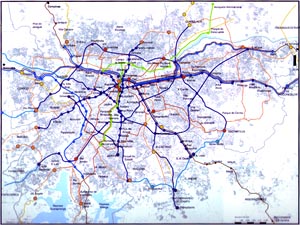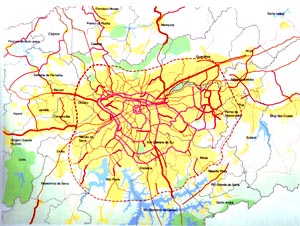

6 Perspectives and major projects
One of the largest scale and most important projects currently underway
is a complete re-planification of the public transport system bringing
it to entirely new levels of performance in terms both of capacity and
levels of service. Aimed at the time-horizon of 2020, a new transportation
plan dubbed PITU 2020 (for Integrated
Plan of Urban Transports). Now this new plan, dubbed PITU 2020, for
Integrated Plan of Urban Transport, is really integrated as far as it encompasses
at least all modalities of the transport system and also it refers to the
whole of the Metropolitan Area, a specific State secretary of the São
Paulo State government (which also runs vernment (which also runs the Metrô) being in charge
of it.
 |
 |
| PITU 2020: Public transport network | PITU 2020: Main road network |
This plan fixed a target of greatly expanding in twenty years all the main elements of the mass transport system: the existing 49 km long Metrô (Underground) network to over 170 km, the currently 30 km long suburban rail lines to 100 km, and adding to them 95km of track for light train lines to operate in the periphery and a special monorail link to connect both new and old airports to the city centre and the Metrô network in twenty minutes. An analysis of three alternatives of geometry led to the choice of a broadly extended network able to become the backbone of the public transport (complemented of course with lighter means such as buses and minivans) for the metropolitan region as a whole, reching out to all the main sub-centres and to huge extensions of the currently half-isolated eastern and northern regions. There may the soon news with respect to both the managemth respect to both the management and the financial ingeneering of the implementation of PITU 2020, for while hitherto the Underground system had been wholly in the hands of the (São Paulo) State through a Company set up to this end in 1968: planning, building (contracted out under strict control of standards set by the Metrô Company) and operation, there have been proposals of several alternatives to attract private entreprises to take part in the implementation of the new plan. Such alternatives remain so far on the drawing board, and the Metrô Company itself will have to adapt to new schemes of operation.
The main feature of the programme for the improvement of the road network is the building of a long overdue Ring Road at a radius of roughly 40km around São Paulo which will put some order into the rather erratic expansion of the urbanized area exclusively along radial axes. It will also help keeping heavy freight traffic out from the more central parts of the city, besides, of course, making tangential movements in the periphery easier.
Equally important is a manifold programme for the recovery of the old centre of the city, after three decades of slow decay while the dynamic centre has been moving gradually south-west. One of the main conditions of this is precisely the rapid transport system described above, which would turn the town centre into the most accessible place agaiccessible place again. But also the historic buildings will have to be refurbished, new legislation put into effect to prepare for new development, other infrastructures such as telephone, optical cable and other telecommunications network will have to be greatly expanded. These initiatives have already brought their first fruits, an example being the refurbishing of a centrally located railway station (Estação Júlio Prestes) and its inauguration as a concert hall and major cultural centre. Private investment will of course also have its part and already there is talk of building a near-500m high (the world’s highest, until a higher yet is built somewhere) mammoth tower in an old district near the old centre, but once the process of recovery is triggered off, more is likely to come.
Proeminent among the the projects dealing with the environment is the Billings Project, which deals with the bigger of the two southern water reservoir systems, and its companion project of water management for the whole basin of the São Paulo Metropolitan Region, which seeks to integrate the needs of water supply and treatment, drainage and flood control, power generation, urban settlement and preservation of the environment. After many decades of debate about the best approach to the preservation of ‘natural’ resources against the encroachments of urbanization, there is growing consensus in towing consensus in that it is better to put the areas of water basins to controlled uses compatible with preservation of the quality of water (such as leisure, thematic parks, low-density but high quality settlements) than to try to preserve them ‘green’ with no use at all, which had led to invasion by illegal settlements which have no sanitation infrastructure altogether, due to total impossibility of controlling such extensions of empty space in the face of the pressure of urbanization and present conditions of control of the land use by local governments of the Metropolitan Region. The new model needs of course among other things, accessibility both by public transport and road, both of which are now envisaged by the PITU 2020 and the Ring Road project respectively, making the great scenic beauty of the lakes publicly available and providing thereby a shield against further deterioration.
Even though there is no specific ‘plan’ to reduce air pollution, a set of measures currently being planned or envisaged should end up by bringing some much-needed relief. Pollution levels run currently so high that people accept rather willingly a ban on driving one-fifth of all cars every day: each car is forbidden in the streets one day of the week in turns, according to the license plate. The expansion of the Metrô will help a lot, both by luring car-owners into leaving their cars home and thus reducing the number of cing the number of cars in the streets and by consequently reducing traffic congestion. But there are also plans to enforce stricter gas-emission standards of new cars and also a lobby for govenment subsidy for replacement of old cars by new (the lobby is of course of the car industry, which jumped at the argument of reducing pollution). All in all, such projects should bring some badly needed improvement in the quality of the urban environment.